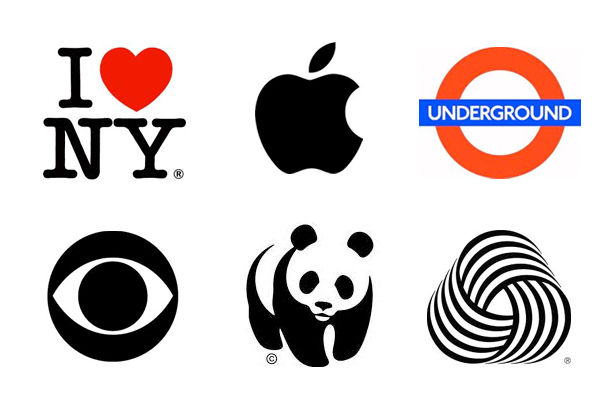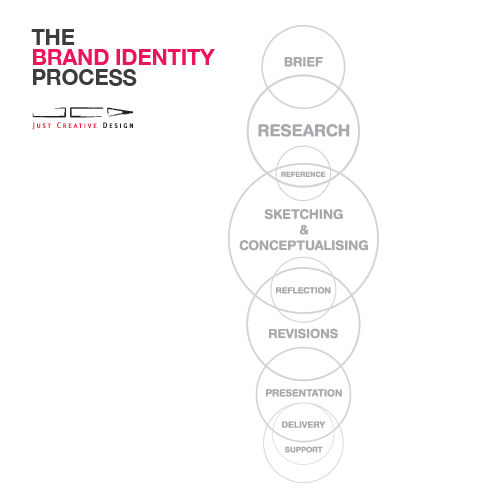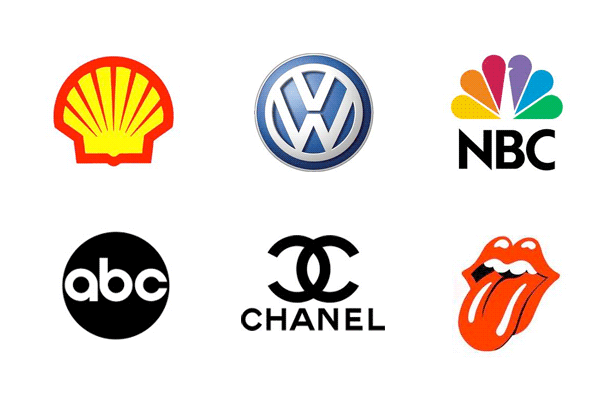Get started with logo design: 10-step guide
Logo designer Jacob Cass offers expert advice and vital tips to help you create the perfect logo.
Before you embark on logo design, you must understand what a logo is and what it is supposed to do. A logo identifies a company or product via the use of a mark, flag, symbol or signature. A logo does not sell the company directly nor rarely does it describe a business. Logos derive their meaning from the quality of the thing they symbolise, not the other way around - logos are there to identity, not to explain. In a nutshell, what a logo means is more important than what it looks like.
To illustrate this concept, think of logos like people. We prefer to be called by our names - Jacob, Emily, Tyler - rather than by the confusing and forgettable description of ourselves such as 'the guy who always wears pink and has blonde hair'. In this same way, a logo should not literally describe what the business does but rather identify the business in a way that is recognisable and memorable.
It is also important to note that only after a logo becomes familiar does it function the way it is intended to do, much like how we must learn people's names to identify them. The logo identifies a business or product in its simplest form. Here are 10 vital tips you need to consider on your way to the perfect logo.
01. Learn logo 101

An effective logo is distinctive, appropriate, practical, graphic, simple in form and conveys an intended message. In its simplest form, a logo is there to identify but to do this effectively it must follow the basic principles of logo design:
- A logo must be simple. A simple logo design allows for easy recognition and allows the logo to be versatile and memorable. Effective logos feature something unexpected or unique without being overdrawn.
- A logo must be memorable. Following closely behind the principle of simplicity is that of memorability. An effective logo design should be memorable and this is achieved by having a simple yet appropriate logo.
- A logo must be enduring. An effective logo should endure the test of time. The logo should be 'future proof', meaning that it should still be effective in 10, 20, 50+ years time.
- A logo must be versatile. An effective logo should be able to work across a variety of mediums and applications.
- A logo must be appropriate. How you position the logo should be appropriate for its intended purpose. For a more detailed explanation see: What makes a good logo?
02. Establish your own design process

Every designer has his or her own process, and it is rarely linear, but in general this is how the branding process is completed, which can be used as a guide to establish your own.
- Design brief. Conduct a questionnaire or interview with the client to get the design brief.
- Research. Conduct research focused on the industry itself, its history, and its competitors.
- Reference. Conduct research into logo designs that have been successful and current styles and trends that are related to the design brief.
- Sketching and conceptualising. Develop the logo design concepts around the brief and research.
- Reflection. Take breaks throughout the design process. This allows your ideas to mature and lets you get renewed enthusiasm. Receive feedback.
- Presentation. Choose to present only a select few logos to the client or a whole collection. Get feedback and repeat until completed.
03. Ask the right questions
A common pitfall before starting a new branding project is to fail to ask the right questions, which includes research on your behalf too. Before you begin your development, get as much information as you can from the client about their business, goals, target market, etc. If possible, try their service or product, visit their store – really get to know them and their requirements.
Some important questions you should ask your client before beginning:
Daily design news, reviews, how-tos and more, as picked by the editors.
- How much do you plan to dedicate to this project?
- Do you have a fixed deadline or timeline in mind for the project?
- What are your goals and why?
- What product or service does your business offer?
- Who is your target audience and who is your most ideal customer?
- Who are your competitors and how do you differ from them?
- What was the idea behind the business name?
For further questions see: How to write a design brief.
04. Price your work accordingly
"How much?" is the single most frequently asked question and it cannot be easily answered because every company has different needs and expectations. You have to take a number of factors into consideration when designing a logo/brand identity, such as how many concepts need to be presented, how many revisions will be needed, how much research is required, how big the business is and so on.
The best approach is to draw up a customised quote for each client and to do this you should learn how to price your designs, which is another topic in itself.
Jeff Fisher, a notable designer and author, had this great point in his article How Much Should I Charge: "The major point I wish to convey here is that all designers need to work smarter in independently determining what their talent, skill and expertise are worth and charge the client accordingly without question or apology. Being smart in determining what you should charge for your work will hopefully allow you to 'work less, charge more' in the future."
05. Learn from others

By knowing what other brands have succeeded in and why they have succeeded gives you great insight and you can apply that attained knowledge to your own work.
For example, let's look at the classic Nike Swoosh (above). This logo was created by Caroline Davidson in 1971 and it's a great example of a strong, memorable logo, being effective without colour and easily scalable.
Not only is it simple, fluid and fast but it also has related symbolism; it represents the wing in the famous statue of the Greek Goddess of Victory, Nike, which is a perfect figure for a sporting apparel business. Nike is just one of many great logos, but think about other famous brands that you know and check out their logos - what makes them successful?

For more quality logos, check out Logo Of The Day or go to your local library/book store and check out some branding books. Also be sure to check out some of these logo design process case studies.
06. Make use of the resources
There are hundreds of resources available, both offline and online, that are dedicated purely to logo and brand design. Here are some of the best:
- The Ultimate List of Logo Design Resources by Just Creative DesignIf you're looking for logo resources, this is the place to go.
- Best Logo Design Books by Just Creative DesignLists some great logo design books.
- Top 10 Logo Design Inspiration Galleries by Logo Designer BlogA list of the top 10 recommended logo design inspiration galleries.
- Logo Design Tips by Steve at The Logo FactoryA great post outlining some very helpful logo design tips.
- How NOT to design a logo from Web Designer DepotAn article outlining ways not to go about getting your logo designed.
- Iconic Logo Designers by David AireyA mini-website of some of the world's most iconic logo designers.
- 45 Rules of Creating A Great Logo Design from Tanner Christensen.A fairly accurate list of 'logo design rules.' Take it as a guide only.
- 80 Beautiful Typefaces for Professional Design from Smashing Magazine.A thorough list of classic typefaces.
07. Choose the right font
When it comes to logos, choosing the right font can make or break the design. Font choice can often take as long as the creation of the logo mark itself, and both the font and mark should work towards the same goal(s).
Spend time researching all the various fonts that could be used for the project, narrow them down further, and then see how each gels with the logo mark, keeping in mind how the logo will used across the rest of the brand identity, in combination with other fonts and imagery.
Don't be afraid to purchase a font, modify one, or create your own. Also stay aware of font licensing issues, especially in free fonts, as they often cannot be used commercially.
For more information read How to choose the right font.
08. Avoid the clichés

Light bulbs for 'ideas', speech bubbles for 'discussion', globes for 'international', etc. These ideas are often the first things to pop into one's head when brainstorming, and for the same reason should be the first ideas discarded. How is your design going to be unique when so many other logos feature the same idea? Stay clear of these visual clichés and come up with an original idea and design.
With this said, please do not steal, copy or 'borrow' other designs. Although, this shouldn't have to be said, it happens too often. A designer sees an idea that he likes, does a quick mirror, colour swap or word change, and then calls the idea his own. Not only is this unethical, illegal and downright stupid but you're also going to get caught sooner or later. Do not use stock or clip art either — the point of a logo is to be unique and original.
09. Limit the concepts sent
Go wild exploring ideas, but don't provide your client with too many options. This means the client will have too much control over the design direction of the project, whereas the designer should be the director - unless you are hired by an agency and have already been given design direction.
If you provide 10 to 20 concepts to a client, more often than not they will choose what you consider the less superior design. A good rule of thumb is to only send one to three concepts that you personally could see working for their business. Of course, the number of concepts you send can change from project to project, but once you feel confident enough as a designer, these one to three concepts should nail the project on the head every time.
10. Deliver the correct files
Delivering the correct files to your client is one way to ensure that your client never comes back asking for revisions or different versions of a logo. It also ensures that the logo gets displayed correctly in all circumstances, which should be supported by a style guide.
You should give your client five high-quality files per logo variation - this means providing a spot-colour file, a pure CMYK file, a pure black file, a pure white knockout file and a RGB file. As a guide, these should generally be in EPS, TIFF (1500x1500 at 300DPI), and JPEG/PNG (800x800 at 72DPI) formats. You could also provide a favicon too.
A closing word
These logo design tips should help you become a better logo designer in theory. However, it's important to state that although lists such as this are a good starting point, they should not hold you back - rules are made to be broken and there is no 'right' way when it comes to logo design. Sketch, explore and create! Then repeat.
Also, it's important to remember that your logo is not your brand, nor is it your identity. Logo design, identity design and branding all have different roles that together form a perceived image for a business or product. Now that you have learned about logo design, you should learn how logos fit into the whole brand identity.
The worst logo applied well is better than the best logo applied poorly.
Words: Jacob Cass
Jacob Cass is a strategic, multidisciplinary designer, art director and blogger living up life in NYC. You can find many more of his articles on his blog Just Creative Design.

The Creative Bloq team is made up of a group of art and design enthusiasts, and has changed and evolved since Creative Bloq began back in 2012. The current website team consists of eight full-time members of staff: Editor Georgia Coggan, Deputy Editor Rosie Hilder, Ecommerce Editor Beren Neale, Senior News Editor Daniel Piper, Editor, Digital Art and 3D Ian Dean, Tech Reviews Editor Erlingur Einarsson, Ecommerce Writer Beth Nicholls and Staff Writer Natalie Fear, as well as a roster of freelancers from around the world. The ImagineFX magazine team also pitch in, ensuring that content from leading digital art publication ImagineFX is represented on Creative Bloq.
